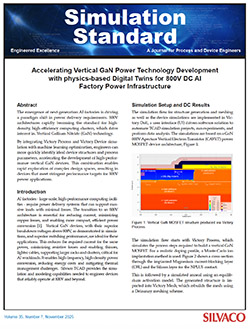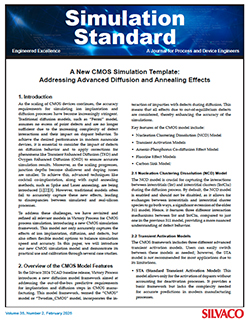
Accelerating Vertical GaN Power Technology Development with Physics-based Digital Twins for 800V DC AI Factory Power Infrastructure
In this paper we will discuss accelerating vertical GaN power technology development with physics-based Digital Twins for 800V DC AI factory power infrastructure.

Dynamic Testing for Power MOSFET
In this paper we demonstrate the application of the Silvaco TCAD suite from the technology process to circuit analysis for a planar SiC MOSFET (DMOS).
The Impedance Field and Small-Signal Noise
This is an introduction to the impedance field method and its application to the calculation of the small-signal noise in Victory Device.
Trajectory Replication in Monte Carlo Ion Implantation with Victory Process
This edition introduces trajectory replication in Victory Process Monte Carlo ion implantation, with a focus on:
- Reducing computation time by reusing ion paths in similar regions
- Maintaining physical accuracy while accelerating simulations
- Best-use cases and scenarios to avoid
- Achieving speed-ups of up to 10×
Victory Process Stress Simulation: Practical Workflows, Best Practices, and Recent Improvements
In this article, we will present application examples of stress analysis in Victory Process.

A New CMOS Simulation Template: Addressing Advanced Diffusion and Annealing Effects
As the scaling of CMOS devices continues, the accuracy requirements for simulating ion implantation and diffusion processes have become increasingly stringent.

Introduction to Virtual Metrology with Victory Extract
Victory Extract is a new tool for the 2024 baseline release. Victory Extract unifies the older extraction offerings from DeckBuild (extract), Victory Process (extract3d) and Victory Mesh (extract3d) and introduces some newer metrology features.

IGBT Switching Simulation Based on the Double-Pulse Method
This article introduces a DPT-based simulation method to perform the transient switching characteristics of an IGBT device. It also provides standard templates for power device switching characteristics and performance assessment using Silvaco TCAD simulation tools. The deck used for this article can be found in Silicon_Power_ex17 of the 2024 Baseline.

2024 TCAD Baseline Release
- Section 1: Process Simulation – New Features in 2024 Baseline Release
- Section 2: Device Simulation – New Features in 2024 Baseline Release
- Section 3: Victory DoE – New Features in 2024 Baseline Release

How Can I Re-Use Individual Monte-Carlo 3D Implant Profiles?
It is often the case that a design of experiments (DOE) is required to optimize the performance of a particular device. Sometimes this simply means tweaking the implant dose for threshold voltage or other minor adjustments, but in other cases it can mean tweaking such things as high energy deep well implants.
